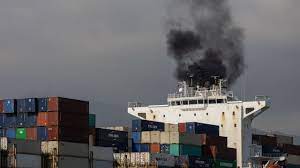The world’s top maritime regulator has agreed to a plan to cut the “carbon-intensity” of ocean-going vessels, overriding objections from Western countries that the accord doesn’t commit the shipping sector to specific emission cuts

The environmental accord struck at an International Maritime Organization meeting in London late Monday includes steps aimed at pushing shipowners to cut the carbon footprint of some 30,000 ocean-going vessels by 40% by 2030, according to a spokesman for the United Nations regulator, and cut overall emissions by half in 2050, compared to 2008 levels.
But as anticipated, the pact set no specific targets, a subject that will not be addressed till 2023.
“Some 80 countries talked and there’s a raft of different opinions on whether this was too much or too little,” said Lars Robert Pedersen, deputy secretary general of Denmark-based shipping trade body Bimco. “It’s pretty doubtful that what was agreed today will actually contribute to the overall CO2-cut goal, but at this point it was a needed compromise to get the process going.”
Read Also: Piracy To Come Under The Spotlight At IMDEC 2021
The plan, the first step the IMO has taken since adopting its initial emissions reductions strategy in 2018, comes as the U.S. and the European Union are pressing for stronger action. The EU is considering its own measures, including adding the shipping sector to the bloc’s carbon-trading scheme.
The IMO plan includes a requirement to measure how much pollution a ship emits and rate its progress in reducing what the group calls carbon-intensity, a measure of a vessel’s carbon-dioxide emissions linked to the volume of cargo moved over a voyage. The plan would aim to lower the carbon-intensity of ships by 2% annually from 2023 to 2026, or a total of 8% compared with 2019 levels.
IMO delegates said the U.S. pushed for a carbon-intensity reduction of 22% by 2026, compared with 2019 levels and was critical of the absence of specific targets from 2027 to 2030.
“The IMO proposals don’t go far enough, and the EU is on track to include shipping in its carbon-emissions trading system,” said an EU legislator involved in the process. “There will be legislative developments later this year.”
The European carbon-trading system under consideration would have ships that operate within the continent pay for their carbon emissions, with the proceeds going toward development of infrastructure for cleaner alternative fuels.
Several IMO member-nations, including Brazil, Argentina, Chile and a host of African nations, pushed for lighter targets. They argue research on cleaner-burning fuels remains inconclusive and that a rapid shift in industry operations would be costly and harm their export-driven economies by making food and other commodities more expensive.
“There is a lot of willingness to move on to market-based measures, regardless of where members stand,’’ said a delegate from a Southeast Asian country who is not authorized by his government to speak on the record. “Creating a market will support cleaner ships, and helping developing nations fund the infrastructure needed for alternative fuels is imperative.”
The IMO will look into proposals for market-based incentives this week and will start discussing the issue in November, with an eye toward adopting such mechanisms by 2024.
The shipping industry accounts for around 2.5% of all global greenhouse-gas emissions, according to the regulator.
Source: Wall Street Journal
















Discussion about this post